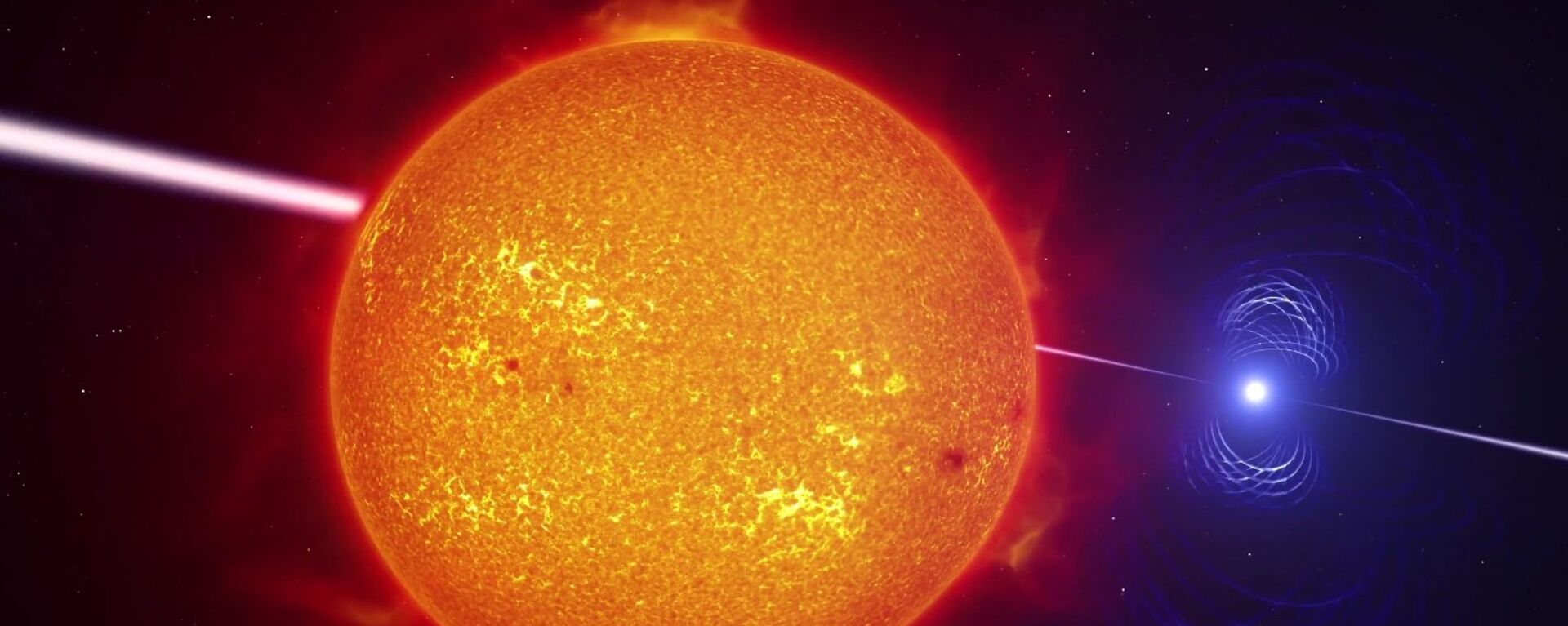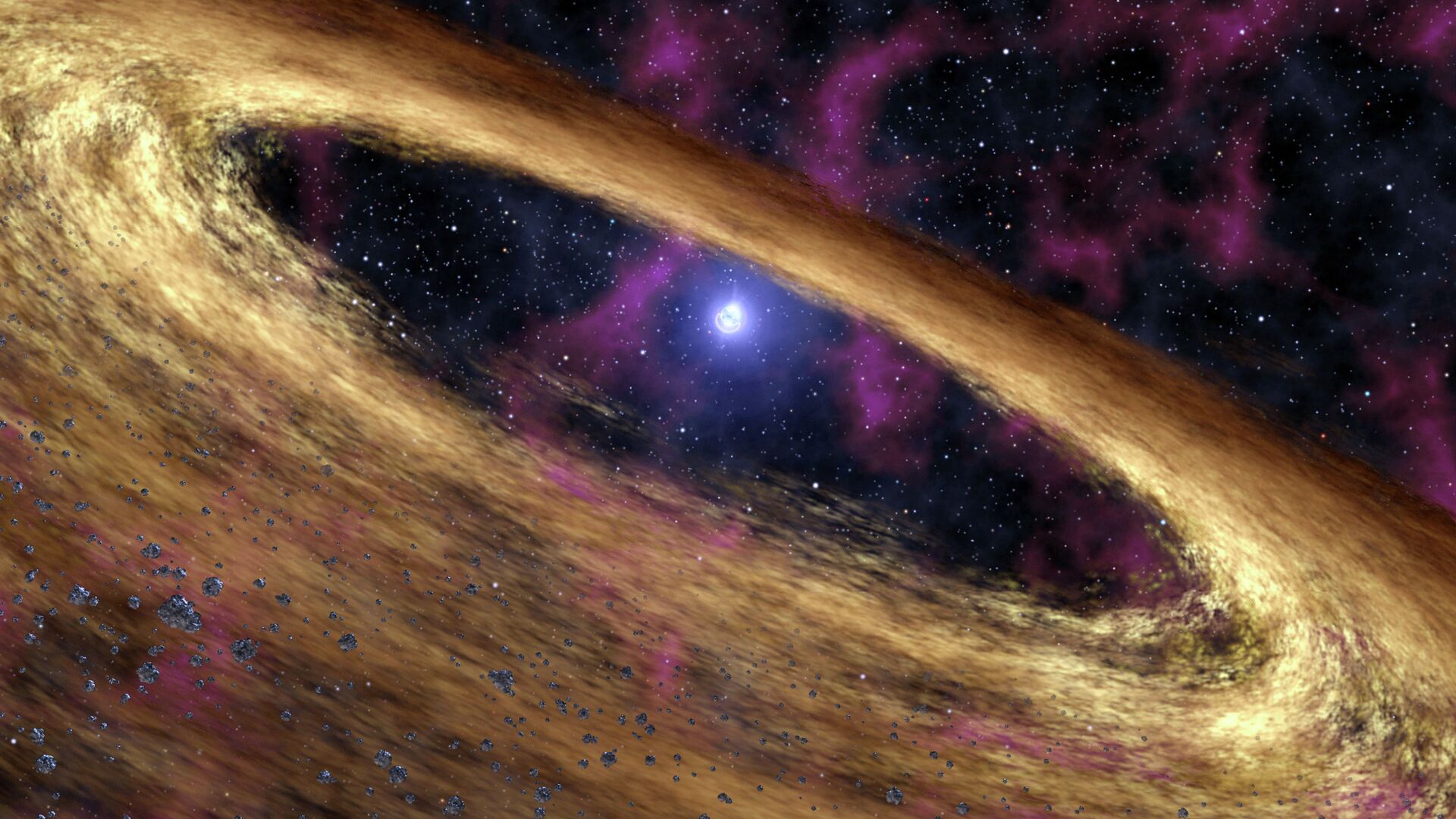https://sputnikglobe.com/20220615/astronomers-detect-ultra-rare-x-ray-millisecond-pulsar-in-milky-way-1096347937.html
Astronomers Detect Ultra-Rare ‘X-Ray Millisecond’ Pulsar in Milky Way
Astronomers Detect Ultra-Rare ‘X-Ray Millisecond’ Pulsar in Milky Way
Sputnik International
First discovered in 1967, pulsars are neutron stars that rotate at extreme speeds, with some of these cosmic objects known to emit short rhythmic bursts of... 15.06.2022, Sputnik International
2022-06-15T14:55+0000
2022-06-15T14:55+0000
2022-06-15T14:55+0000
japan
pennsylvania
pulsar
scientists
neutron star
https://cdn1.img.sputnikglobe.com/img/101674/25/1016742579_0:300:3200:2100_1920x0_80_0_0_ed42ae7b543823d53fdb1d5e6fca761a.jpg
An ultra-rare pulsar emanating X-ray light was recently detected in the Milky Way, an international team of astronomers has revealed.The nearest pulsars to our planet are located more than 100 light-years away, where one light year is approximately equal to 9.5 trillion kilometres.Only 18 other pulsars, which are similar to MAXI J1816-195, are currently known to scientists, according to a database compiled by astronomer Alessandro Patruno.Regarding the details of the newly discovered pulsar, astronomers from the Tokyo-based Nihon University described the object as a “new accreting X-ray millisecond pulsar”, which means that it is spinning at a rate of 528.6 times per second, in addition to its X-ray thermonuclear burst - characteristics that place MAXI J1816-195 in an ultra-rare category of pulsars.Astrophysicist Hitoshi Negoro and his colleagues from Nihon University managed to detect X-ray light emanating from the pulsar, but failed to identify the object despite the help of the Japanese Space Agency's Monitor of All-Sky X-Ray Image (MAXI) instrument mounted on the outside of the International Space Station.However, astrophysicists from Pennsylvania State University quickly lent a hand, confirming the detection and location of the new pulsar with an independent instrument.Pulsars are a class of neutron star first discovered in 1967 by British astrophysicist Jocelyn Bell Burnell. Neutron stars are typically formed after massive stars run out of fuel and collapse under their weight to produce a powerful supernova.Packed with energy, some pulsars are capable of spinning up to several hundred times a second, spewing electromagnetic and X-ray radiation into outer space.
https://sputnikglobe.com/20170208/white-dwarf-pulsar-star-discovered-1050484089.html
japan
pennsylvania
Sputnik International
feedback@sputniknews.com
+74956456601
MIA „Rossiya Segodnya“
2022
Oleg Burunov
https://cdn1.img.sputnikglobe.com/img/07e4/09/0b/1080424846_0:0:2048:2048_100x100_80_0_0_3d7b461f8a98586fa3fe739930816aea.jpg
Oleg Burunov
https://cdn1.img.sputnikglobe.com/img/07e4/09/0b/1080424846_0:0:2048:2048_100x100_80_0_0_3d7b461f8a98586fa3fe739930816aea.jpg
News
en_EN
Sputnik International
feedback@sputniknews.com
+74956456601
MIA „Rossiya Segodnya“
Sputnik International
feedback@sputniknews.com
+74956456601
MIA „Rossiya Segodnya“
Oleg Burunov
https://cdn1.img.sputnikglobe.com/img/07e4/09/0b/1080424846_0:0:2048:2048_100x100_80_0_0_3d7b461f8a98586fa3fe739930816aea.jpg
japan, pennsylvania, pulsar, scientists, neutron star
japan, pennsylvania, pulsar, scientists, neutron star
Astronomers Detect Ultra-Rare ‘X-Ray Millisecond’ Pulsar in Milky Way
First discovered in 1967, pulsars are neutron stars that rotate at extreme speeds, with some of these cosmic objects known to emit short rhythmic bursts of visible light, X-rays, and gamma radiation.
An ultra-rare pulsar emanating X-ray light was recently detected in
the Milky Way, an international team of astronomers has revealed.
The researchers, who named the pulsar MAXI J1816-195, explained that this celestial body is located no more than 30,000 light-years away from Earth.
The nearest pulsars to our planet are located more than 100 light-years away, where one light year is approximately equal to 9.5 trillion kilometres.
Only 18 other pulsars, which are similar to MAXI J1816-195, are currently known to scientists, according to a database compiled by astronomer Alessandro Patruno.
Regarding the details of the newly discovered pulsar, astronomers from the Tokyo-based Nihon University described the object as a “new accreting X-ray millisecond pulsar”, which means that it is spinning at a rate of 528.6 times per second, in addition to its X-ray thermonuclear burst - characteristics that place MAXI J1816-195 in an ultra-rare category of pulsars.
Astrophysicist Hitoshi Negoro and his colleagues from Nihon University managed to detect X-ray light emanating from the pulsar, but failed to identify the object despite the help of the Japanese Space Agency's Monitor of All-Sky X-Ray Image (MAXI) instrument mounted on the outside of the International Space Station.

8 February 2017, 19:11 GMT
However, astrophysicists from Pennsylvania State University quickly lent a hand, confirming the detection and location of the new pulsar with an independent instrument.
Scientists hope that discovering MAXI J1816-195 “can yield important statistical information about how those objects form, evolve, and behave”, according to the news website sciencealert.com.
Pulsars are a class of neutron star first discovered in 1967 by British astrophysicist Jocelyn Bell Burnell. Neutron stars are typically formed after massive stars run out of fuel and collapse under their weight to produce a powerful supernova.
Packed with energy, some pulsars are capable of spinning up to several hundred times a second, spewing electromagnetic and X-ray radiation into outer space.



